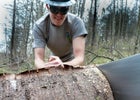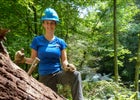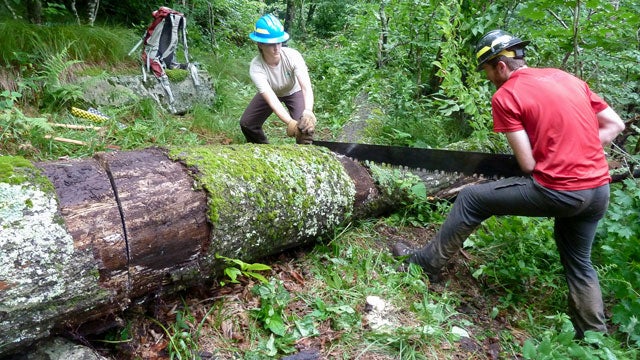A few years ago, when Bill Hodge was meeting with various groups to drum up support for the Tennessee Wilderness Act, a bill that would add protections to 20,000 acres of the Cherokee National Forest and create the first new wilderness area in Tennessee in 25 years, he figured he could count on the support of local trail crews from organizations such as Tennessee Eastman Hiking and Canoe Club and the Southern Appalachian Backcountry Horsemen. After all, these groups log thousands of volunteer hours to maintain trails in the National Forests and other public lands.
Bill Hodge:
“I suggested we form SAWS and I got a hardy amen.” A SAWS volunteer cutting through a downed tree. This non-profit focuses on trail restoration through year-round crews and volunteers.
A SAWS volunteer cutting through a downed tree. This non-profit focuses on trail restoration through year-round crews and volunteers. While cutting downed trees and maintaining trails in the Bald River Gorge Wilderness, Tenn, a SAWS volunteer poses for a picture. In addition to trail maintenance, this also non-profit gathers and analyzes data on wilderness areas.
While cutting downed trees and maintaining trails in the Bald River Gorge Wilderness, Tenn, a SAWS volunteer poses for a picture. In addition to trail maintenance, this also non-profit gathers and analyzes data on wilderness areas.But he was wrong. These groups opposed the bill. That's not because they necessarily oppose wilderness, but because the designation would take a number of trail-miles that they currently maintain with chainsaws and weed eaters and place them into a wilderness system, which means they would only be able to use hand tools in those zones.
Before you go and paint these folks lazy, consider this salient fact: many of them are past retirement age. They were seeing no evidence that younger hikers, horsemen, paddlers or other users of the trails they maintain were coming in and picking up the torch. If they found themselves restricted from using power tools, they worried that many of the trails they rely on would become overgrown and unusable. So Hodge, who works for , took the hint.
“We put together a wilderness trail summit in 2010 and we invited every hiking and horsemen club that was already working on trails [in the region],” says Hodge. “We had 50 folks, who represent 40-45 clubs, attended the one-day session. I wanted them all to hear each other say the same things, and they all did what I thought they would do. They brought up lack of young people [working on trails]. At end of meeting I suggested we form SAWS and I got a hardy amen.”
, a nonprofit organization that Hodge established as a vehicle for drumming up interest in trail maintenance among the college-and-older set. The group, which is supported financially through The Wilderness Society, quickly grew to more than 500 volunteers over the last three years, and this year alone SAWS supported 5,000 volunteer hours and 22 seasonal employees – that's up from 6 seasonal jobs in 2012. “Well over 100 miles of trail have been restored and rehabilitated, and they built one new trail and did several reroutes on old trails,” says Hodge.
The key to stoking so much interest in trail maintenance? The crosscut saw and the human ego. While it might seem very intuitive, using a crosscut saw efficiently and effectively requires a learning curve. Hodge tapped into the volunteer's natural competitiveness and found that his volunteers didn't just want to maintain trails, they wanted to cut through felled trees and clear brush better and more quickly than their buddies.
“That's why the crosscut saw is a gateway drug,” says Hodge. “It resonates with them because it requires muscle, not engines.”
Going Deeper
SAWS is also filling an important niche by conducting multi-day trips that go far deeper into forests than volunteer crews working only for an afternoon or weekend can go. Beyond that, of course, is the notion that the more time trail workers spend toiling out there, the more invested they will become in working to protect wilderness, or at least national forests.
SAWS is certainly not alone in trying to keep the Generation Y interested in stewardship. It joins sport-specific organizations such as the , the (for climbers) and the , each of which have stewardship programs focused on improving trail systems – generally to improve access to and reduce impact from specific users.
“I don't think I would say that 'there are no young people who are interested in trail work.'” says Ty Tyler, stewardship director at Access Fund. “I would say that the younger generations are currently limited in their experience in what it takes to maintain and manage outdoor recreation pursuits.”
But that limited experience is a growing concern as more climbers make the transition from indoor to outdoor climbing. “Currently, there aren't any hard statistics on the numbers. But, the climbing community certainly has a gut feeling that the increase in gym numbers is helping to increase the sport's popularity and the numbers [of climbers] who are headed outdoors,” says Tyler.
Access Fund runs as program to help protect specific climbing areas and it supports a small conservation team that tours the country to offer education and training programs.
Long View
“Some people still argue that chainsaws are the answer,” says Hodge, “And that they should be allowed in wilderness.” But he says most of his time is spent organizing events and volunteers, working on the logistics of getting them to and from the forests, feeding them and training them on the tools and how to actually build trails. “Once we’re at the trailhead, it take hours or days to get to the work site,” he says, while the argument over whether manual or mechanized tools are best focuses on the “last two percent of the time” spent on trail work.
The more important conversation, he says, is about the value of doing the actual trail work. Does using a hand tool versus a power tool make someone a better steward? Does it help her connect more deeply with her surroundings? Maybe and maybe not, but it certainly makes the wilderness of experience more pleasant for anyone within earshot of the work site.
In either case, says Hodge, “Trail systems are important for environment health and mental health,” because they get people into the woods and away from their desks and cars and jobs. But looking ahead, he adds, “In this era of austere government spending, the focus is going to remain on volunteers” to do a bigger chunk of work maintaining trails.


